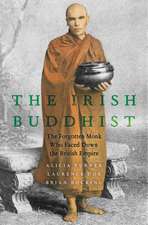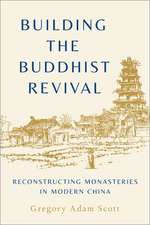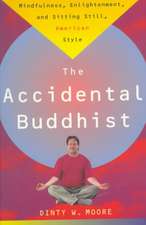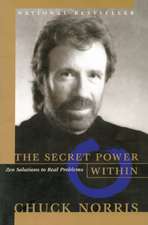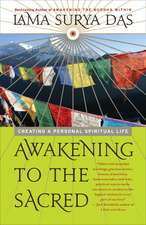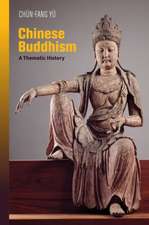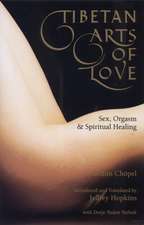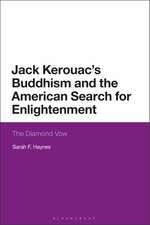The Beginner's Guide to Walking the Buddha's Eightfold Path
Autor Jean Smithen Limba Engleză Paperback – 30 iun 2002
The third of Jean Smith’s Beginner’s Guides focuses on the Buddha’s Eightfold Path—the concepts central to practicing the Buddha’s teachings in daily life. The eight steps on the path are: right understanding, thought, speech, action, livelihood, effort, mindfulness, and concentration. Smith explains exactly what the Buddha had in mind, using translations of his own words and then elucidating them for us. Throughout the book are wonderful quotes from a broad range of Buddhist teachers, giving a taste of the very best each of them has to offer. The Beginner’s Guide to Walking the Buddha’s Eightfold Path is a prescription for happiness, not just for overcoming suffering, which is how many people think of Buddhism. Here is a book for Buddhists of every tradition.
Preț: 99.94 lei
Nou
Puncte Express: 150
Preț estimativ în valută:
19.12€ • 20.02$ • 15.82£
19.12€ • 20.02$ • 15.82£
Carte disponibilă
Livrare economică 15-29 martie
Preluare comenzi: 021 569.72.76
Specificații
ISBN-13: 9780609808962
ISBN-10: 0609808966
Pagini: 256
Dimensiuni: 132 x 204 x 14 mm
Greutate: 0.2 kg
Editura: HARMONY
ISBN-10: 0609808966
Pagini: 256
Dimensiuni: 132 x 204 x 14 mm
Greutate: 0.2 kg
Editura: HARMONY
Notă biografică
Jean Smith is the author of The Beginner’s Guide to Zen Buddhism, the coauthor of The Beginner’s Guide to Insight Meditation, and the editor of four much-admired collections of Buddhist teachings: Breath Sweeps Mind, Everyday Mind, Radiant Mind, and 365 Zen. She lives in Keene, New York, and Taos, New Mexico.
Extras
Right Understanding
During the late 1980s visitors to New York City's Times Square were surprised and puzzled to observe, among all the flashing neon lights, the enormous words protect me from what I want, center stage on the Spectacolor marquee above them. When artist Jenny Holzer installed this slogan-one of her personal "truisms," about how advertising elicits desire for things we do not need and may not even want-intentionally or not she was making a compelling comment on the Buddha's Four Noble Truths and the barrier to happiness that each of us encounters.
Teachings
The first step of the Eightfold Path--right understanding, also called right view--like many spiritual conditions, emerged from the personal experiences of one individual, in this case the man we know as the Buddha ("Awakened One"). The historical Buddha was born Siddhartha Gautama, a prince of the Sakya clan (Shakyamuni Buddha), in the Himalayan foothills of Nepal in the sixth century b.c.e. Before his birth, a seer had foretold that the child would grow up to be either a great ruler or a great holy man, and his father did everything possible to ensure that Siddhartha would actualize the first possibility rather than the second and succeed him as the chief of the clan. Siddhartha was exposed to continuous sense pleasures while being shielded from anything unpleasant that might divert him from the course his father had set for him. Nevertheless, as an adult, on each of four outings from the palace, Siddhartha had an experience that stunned him. He encountered, for the first time in his life, a very sick person, a very old person, mourners around a person who had died, and an ascetic holy man, a sadhu. Each time, Siddhartha asked his charioteer what he was seeing, and he was shocked to learn that illness, old age, and death are inescapably part of the human condition-including his own-and that there are spiritual seekers questioning just what it means to be born into this human body and to have to endure such suffering.
At the age of twenty-nine, Siddhartha renounced his lavish life, left his family, and sought the meaning of human life among the greatest teachers of northern India as an ascetic who sometimes, it is said, ate only one grain of rice a day. His quest and his subsequent teachings were rooted in their yogic traditions, in which individuals renounced life as householders in order to seek spiritual truth. After six years he realized that he could no more Wnd spiritual answers by living a life of stark deprivation than through princely self-indulgence, and he embraced what has come to be known as the Middle Way between such extremes. On the night of the full moon in May on his thirty-fifth birthday, Siddhartha sat beneath a bodhi (fig) tree near Bodhgaya, in northern India, and vowed not to get up until he had achieved full enlightenment. Over the course of that night, he experienced all the temptations to which the mind is vulnerable, saw human suffering over many lifetimes, and came to understand the Four Noble Truths as well as the law of karma (causality), the impermanence of all conditioned things, and the absence of an autonomous and permanent self.
During the late 1980s visitors to New York City's Times Square were surprised and puzzled to observe, among all the flashing neon lights, the enormous words protect me from what I want, center stage on the Spectacolor marquee above them. When artist Jenny Holzer installed this slogan-one of her personal "truisms," about how advertising elicits desire for things we do not need and may not even want-intentionally or not she was making a compelling comment on the Buddha's Four Noble Truths and the barrier to happiness that each of us encounters.
Teachings
The first step of the Eightfold Path--right understanding, also called right view--like many spiritual conditions, emerged from the personal experiences of one individual, in this case the man we know as the Buddha ("Awakened One"). The historical Buddha was born Siddhartha Gautama, a prince of the Sakya clan (Shakyamuni Buddha), in the Himalayan foothills of Nepal in the sixth century b.c.e. Before his birth, a seer had foretold that the child would grow up to be either a great ruler or a great holy man, and his father did everything possible to ensure that Siddhartha would actualize the first possibility rather than the second and succeed him as the chief of the clan. Siddhartha was exposed to continuous sense pleasures while being shielded from anything unpleasant that might divert him from the course his father had set for him. Nevertheless, as an adult, on each of four outings from the palace, Siddhartha had an experience that stunned him. He encountered, for the first time in his life, a very sick person, a very old person, mourners around a person who had died, and an ascetic holy man, a sadhu. Each time, Siddhartha asked his charioteer what he was seeing, and he was shocked to learn that illness, old age, and death are inescapably part of the human condition-including his own-and that there are spiritual seekers questioning just what it means to be born into this human body and to have to endure such suffering.
At the age of twenty-nine, Siddhartha renounced his lavish life, left his family, and sought the meaning of human life among the greatest teachers of northern India as an ascetic who sometimes, it is said, ate only one grain of rice a day. His quest and his subsequent teachings were rooted in their yogic traditions, in which individuals renounced life as householders in order to seek spiritual truth. After six years he realized that he could no more Wnd spiritual answers by living a life of stark deprivation than through princely self-indulgence, and he embraced what has come to be known as the Middle Way between such extremes. On the night of the full moon in May on his thirty-fifth birthday, Siddhartha sat beneath a bodhi (fig) tree near Bodhgaya, in northern India, and vowed not to get up until he had achieved full enlightenment. Over the course of that night, he experienced all the temptations to which the mind is vulnerable, saw human suffering over many lifetimes, and came to understand the Four Noble Truths as well as the law of karma (causality), the impermanence of all conditioned things, and the absence of an autonomous and permanent self.


